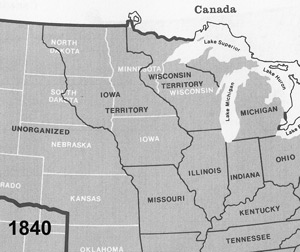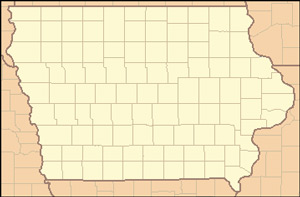The following article is excerpted from William Dollarhide’s latest book, Iowa Name Lists, 1833-2004, Published and Online Censuses & Substitutes 1833-2004.
For genealogical research in Iowa, the following timeline of events should help any genealogist understand the area with an historical, jurisdictional, and genealogical point of view.
1673 Mississippi River. French explorers Jacques Jolliet and Louis Marquette left their base in Quebec, and made their way to the Illinois River, which they descended to become the first Europeans to discover the Mississippi River. After canoeing up river to discover the mouth of the Wisconsin River, they floated down the Mississippi, passing by the present states of Illinois, Iowa, Missouri, Kentucky, Tennessee, Arkansas, and Mississippi, as far south as the mouth of the Arkansas River. Returning to the Great Lakes area, their journals reported the location of several streams flowing into the west side of the Mississippi from the interior of present Iowa. The three largest of the rivers were later identified as the Demoine, Ioway, and Cedar rivers.
1682 Louisiana. Following the same route as Jolliet and Marquette, René-Robert Cavelier (Sieur de LaSalle) floated down the Mississippi River, but continued all the way to its mouth at the Gulf of Mexico. He claimed the entire Mississippi Basin for Louis XIV of France, for whom Louisiana was named.
1685-1720. During this period, La Louisiane Française extended from the Highlands (Terra Haute) on the Wabash River, down the Ohio and Mississippi Rivers to include New Orleans. The French also considered the early ports of Biloxi, Mobile, and Pensacola as part of La Louisiane Française. Forts and settlements established by the French in the Mississippi Basin during this period were Prairie du Chien (now Wisconsin) in 1685; Arkansas Post in 1686; Kaskaskia (now Illinois) in 1703; Natchez (now Mississippi) in 1716; New Orleans in 1718; Baton Rouge in 1719; And Fort de Charles (now Illinois) in 1720. Of these settlements, just two of them included farming activities (Prairie du Chien and Arkansas Post), the others were mostly trading posts established to support the French Fur Trade.
1721. In this year, French colonists abandoned Arkansas Post, the largest settlement of all of French Louisiana. As a failed farming community, Arkansas Post was typical of the French efforts to colonize North America south of the Great Lakes. Arkansas Post continued as a small trading post, and the French presence in the Mississippi Basin became one of mostly single French fur trappers and traders paddling their canoes from one trading post to the next.
1722-1762. During this period of La Louisiane Française, more settlements and trading posts were established at Fort du Rocher (now Illinois) in 1722; Fort Orleans (now Missouri) in 1723; Fort Beauharnois (now Minnesota) in 1727; Vincennes (now Indiana) in 1732; Ste. Genevieve (now Missouri) in 1735; Fort Assumption (near present Memphis, Tennessee) in 1739; Fort de Chavagnial (now Kansas) in 1744; Rock Island (now Illinois) in 1750; and Fort Massac (now Illinois) in 1757. By 1762, the French had built one road that was 12 miles long, and that was only to provide portage between rivers. Unlike the French Québec settlements, French Louisiana had very few farming communities, and there was little exchanging of goods or produce, except for the trapping and trading of furs. In comparison, the British colonies by 1762 had over 2,500 miles of improved wagon roads, between Boston and Savannah. The British colonies had an economy based on town tradesmen surrounded by small farms, with the exchange of goods and produce up and down the Atlantic coast.
1763 Treaty of Paris. The Seven Years War (in Europe and Canada), was called the French and Indian War in colonial America and ended with the 1763 Treaty of Paris. France lost virtually all of its North American claims – the western side of the Mississippi was lost to Spain, the eastern side of the Mississippi and all of Quebec was lost to Britain. The French retained only some fishing rights and islands near Newfoundland. The British also gained Québec from the French, and in another provision of the 1763 treaty, the British acquired Florida from the Spanish in exchange for Cuba.
1763-1770 Transition Period. St. Louis was founded in 1764 by French Trader Pierre Laclede Liguest, after obtaining a trading license from the Spanish government. There was little government or military interference by anyone in former French La Louisiane. The entire region was still inhabited mostly by French fur trappers and traders. Although all French military personnel had left their posts in North America by 1764, civilian French settlements and trading posts still operated in Lower Louisiana (including Arkansas Post, Baton Rouge, and Natchez); and in Upper Louisiana (including Prairie du Chien, Kaskaskia, and Vincennes). The transition from French control to Spanish or British control took up to seven years. Per terms of the Treaty of Paris of 1763, British forces began the evacuation of French Acadians from their homes in Nova Scotia. The first shipload of Acadians arrived in Spanish Luisiana, just west of New Orleans, in February 1765. The Louisiana Rebellion of 1768 was an unsuccessful attempt by Creole and German settlers around New Orleans to stop the handover of French La Louisiane to Spain. St. Louis operated under French civilian control until it was occupied by Spanish soldiers in 1770. About the same time, the British established military jurisdiction over the main Upper Louisiana French settlements at Prairie du Chien, Kaskaskia and Vincennes.
1783 United States of America. The treaty of Paris of 1783 first recognized the United States as an independent nation, with borders from the Atlantic Ocean to the Mississippi River, and from present Maine to Georgia. The treaty also reaffirmed the claims of Britain to present Canada; and Spain’s claim to East Florida, West Florida, New Spain (including Spanish Nuevo Mexico and Spanish Tejas), and Louisiana west of the Mississippi River.
1788. French Canadian Julien Dubuque became the first white settler in present Iowa, near the present city that bears his name. He was given permission by the Meskwaki Indians to mine for lead there in 1788, and given a land grant from the Spanish in 1798.
1800-1802 Louisiana. In Europe, Napoleon defeated the Spanish in battle and gained title to Louisiana again after trading them a couple of duchies in Italy. However, Napoleon found that his troops in the Caribbean were under siege and unable to provide much help in establishing a French government in Louisiana. Several months later, when American emissaries showed up in Paris trying to buy New Orleans from him, Napoleon decided to unload the entire tract.
1803 Louisiana. Surprised and delighted that Napoleon was willing to sell the entire tract called Louisiana, President Thomas Jefferson urged Congress to vote in favor, and the U.S. purchased the huge tract from France, doubling the size of the United States. But, disputed claims now existed due to Spain’s interpretation of the extent of Nuevo Mexico and Spanish Tejas, particularly the ownership of the Lower Louisiana areas of the Arkansas, Sabine, and Red rivers. The extensive division line between New Spain and the U.S. remained in dispute until the Adams-Onis Treaty of 1819.
1804. Lewis and Clark’s Corps of Discovery left St. Louis, then headed up the Missouri River in search of a passage to the Pacific Ocean. Soon after, Spanish troops were dispatched from Santa Fe into present Colorado and Kansas to intercept and arrest them, but Lewis and Clark had already passed by present Iowa and Nebraska, and were well into present South Dakota by the time the Spanish troops finally gave up looking for them.
1804-1805. In 1804, Congress divided the Louisiana Purchase into two jurisdictions: Louisiana District and Orleans Territory. The latter had north and south bounds the same as the present state of Louisiana, but did not include land east of the Mississippi River, and its northwestern corner extended on an indefinite line west into Spanish Tejas. For a year, Louisiana District was attached to Indiana Territory for judicial administration, but became Louisiana Territory with its own Governor on July 4, 1805.
1805. U.S. Army Lieutenant Zebulon Pike led a small party of soldiers to investigate the Mississippi River above St. Louis. He was given specific orders to find the source of the Mississippi, and while doing so, to note “…any rivers, prairies, islands, mines, quarries, timber, and any Indian villages and settlements encountered.” As instructed, Pike recorded the location of the Demoine, Ioway, and Cedar rivers in present Iowa.
1805. Michigan Territory was created, taken from the early Indiana Territory. After the statehoods of Ohio, Indiana, and Illinois, Michigan Territory was increased in size. By 1818, the entire region north of those three states became part of a Michigan Territory that extended west to the Mississippi River.
1805-1806. The Louisiana Territory in 1805 had five original subdivisions: St. Louis District, St. Charles District, Ste. Genevieve District, Cape Girardeau District and New Madrid District. In 1806, the territorial legislature created the District of Arkansas from lands ceded by the Osage Indians. The unpopulated area north of these original districts was known as “Upper Louisiana Territory,” and included the area of present Iowa.
1806-1807 2nd Pike Expedition. Zebulon Pike, now a Captain, was again sent out, this time to explore and locate the source of the Red River in Lower Louisiana. Pike followed the Arkansas River through present southwest Kansas into Colorado and on to the Rocky Mountains, where Pike’s Peak was named for him. On his return, he skirted south in search of the headwaters of the Red River, putting him in an area claimed by the Spanish. Pike and his men were arrested by Spanish soldiers, taken to Santa Fe, but treated well and returned to the Arkansas River a short time later. Pike wrote a book about his travels in 1810 that was a best seller in both America and Europe. In addition to the first English language observations of the Spanish culture in North America, Pike’s descriptions of the Rocky Mountains became the inspiration for a whole generation of “mountain men.”
1812. June 4th. Louisiana Territory was renamed Missouri Territory. This was to avoid any confusion after Orleans Territory became the State of Louisiana on April 30, 1812. The General Assembly of the Territory of Missouri met in October, and converted the first six original districts into counties: Arkansas, Cape Girardeau, New Madrid, St. Charles, St. Louis, and Ste. Genevieve. The area of present Iowa was without any enumerated population, lying north of St. Charles District in the “Unattached” region of the territory.
1819. Arkansas Territory was created, taken from the southern area of Missouri Territory. The area included all of present-day Arkansas and most of Oklahoma.
1819 Adams-Onis Treaty. The treaty included the purchase of Florida, but also set the boundary between the U.S. and New Spain (now Mexico), from Louisiana to the Oregon Country. The treaty established the Sabine and Red River border with Spanish Tejas; the Arkansas River border with Nuevo Mexico; and the 42nd Parallel border with Spanish California. The treaty was named after John Quincy Adams, U.S. Secretary of State, and Luis de Onis, the Spanish Foreign Minister, the parties who signed the treaty at Washington on February 22, 1819. John Quincy Adams was given credit for a brilliant piece of diplomacy by adding the western boundary settlements with Spain to the Florida Purchase.
1820. The “Missouri Compromise” in Congress allowed Missouri to enter the Union as a slave state and Maine as a free state, thus keeping the balance of slave and free states equal in Congress. Although Missouri was allowed to enter as a slave state, the remainder of the Missouri Territory areas north of Latitude 36° 30,’ including present Iowa, were supposed to be forever free of slavery. After Missouri became a state, the remaining part of old Missouri Territory was described as “Unorganized Territory.”
1830. At the time of the 1830 federal Census, present Iowa was part of the “Unorganized Territory” and had no enumerated population.
1832 Black Hawk War. Indian leader Black Hawk of the Sauk and Fox tribe led a sizable force of warriors across the Mississippi River into Illinois, seeking to reclaim lands they had lost to the whites earlier. The U.S. met the threat with a voluntary force of militia raised mostly in Illinois. (Abraham Lincoln’s only military service was in this war, where he was elected a militia Captain by his New Salem neighbors). As a result of the defeat of Black Hawk’s forces at the battle of Bad Axe, the Sauk and Fox, natives of lands near the Ioway River, were forced to cede land on the west side of the Mississippi River to the United States.
1833. 1 June. The Ioway country was open for legal white settlement for the first time. It is estimated that before that date, there were fewer than 40 non-Indians living in the present Iowa region. Most were left-over French-Canadian fur traders. The area was still part of “Unorganized Territory.”
1836 Wisconsin Territory was split off from Michigan Territory. For the first capital of Wisconsin Territory was at Burlington (now Iowa). At that time, Wisconsin Territory included all of Wisconsin, all of Minnesota; all of Iowa; and North and South Dakota east of the Missouri River – same as the combined areas of Wisconsin and Iowa Territory shown on the 1840 map below.
1838. Iowa Territory was created, taken from Wisconsin Territory, including lands between the Mississippi and Missouri Rivers. Iowa City was named the territorial capital, but Burlington served as the interim capital until Iowa City could provide facilities for a governor and legislature, which it did in 1841.

1838-1857 Iowa County Formation. The first appointed governor of Iowa Territory was Robert Lucas, who served from 1838 to 1841. Lucas was an army general during the War of 1812 and an elected governor of Ohio, 1832-1836. Early in his term as Governor of Iowa Territory, Lucas proposed to the legislature a method of county formation in Iowa that was based on the Range/Township lines, with a dedicated section (1 square mile) of land set aside for a courthouse/county seat for each county near its geographic center. However, Lucas had poor relations with the legislature and they rejected his proposal. Although Lucas’ county plan was never officially adopted, a similar method was followed for the formation of virtually all of Iowa’s counties. By 1857, all of Iowa’s current 99 counties had been formed, and there have been very few changes to the boundaries since. Iowa has more “box counties” and the fewest number of counties formed along the lay of the land than any other state.

1840 Iowa Territory. In the 1840 Federal Census, Iowa Territory’s population of 43,112 persons was limited to the 18 counties formed within the Indian Cession lands of 1832-1837. Although destined to become a free state, a total of 6 males and 10 female slaves were counted, all in Dubuque County. See the 1840 Iowa County Map on page IA-10, Iowa Name Lists book.
1846. Leaving their homes in Nauvoo, Illinois, about 20,000 Mormons crossed the Mississippi River and proceeded across the entire length of Iowa. They were headed to their winter quarters on the Missouri River, near present Council Bluffs, Iowa.
1846. Dec. 28th. Iowa became the 29th state. Iowa City continued as the state capital.
1857. The capital of Iowa was moved from Iowa City to Des Moines.
1959. Jan 1st. The University of Iowa Hawkeyes won their Rose Bowl appearance, defeating the California Golden Bears by a score of 38-12. Iowa was named the NCAA National Champion in football that season.
For Further Reading: Iowa Name Lists, 1833-2004, Published and Online Censuses & Substitutes 1833-2004.
Note that all the printed 16 Dollarhide Name List books Alabama through Iowa, with a free immediate PDF download of the entire book, are on sale for 21% off through midnight Sunday MDT March 23, 2014 (making them just $14.97 each). In addition, the immediate PDF downloads themselves are also on sale for 10% off, making them only $11.25 each, also through midnight Sunday MDT March 23, 2014.
See http://www.genealogyblog.com/?p=31257 for details on the promotion.
